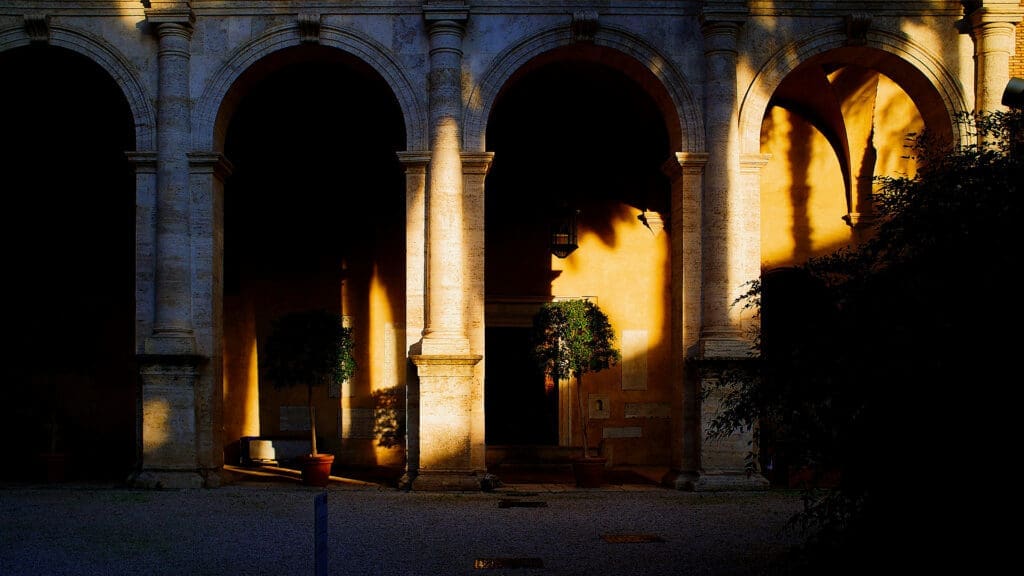A
As a young man living in New York, I often visited the city’s great churches and cathedrals. Most bear the name of a saint—St. Patrick, St. Thomas, St. John the Divine. I was not religious then, but I was drawn to these magical spaces and the peace I found inside them.
It’s somewhat odd that these buildings still exist in the Manhattan landscape. The lots on which they sit are among the most valuable on earth, and New York has grown increasingly secular. When these churches were built, they were dramatic and imposing. Now they are dwarfed by modern high-rises that leave them in near-permanent shadow.
Getting to these cathedrals can be stressful, because New York is stressful. You descend and ascend from crowded train stations. The noises of the street assault you. But upon entering a cathedral’s narthex, all of this slips away. The sounds of hydraulic brakes and car horns fade into silence as the massive doors close behind you.
Your eyes adjust to the darkness, and shapes come into focus—statues in distant alcoves, lanterns hanging from the ceiling. Entering the nave, you hear your footsteps on the stone tiles below and a moment later hear them again as they echo against the vaulted ceilings high above you. There is a sensual feeling of spaciousness, quiet, and wonder.
Eventually you arrive at the sanctuary, the centre of the church. The sanctuary is to a cathedral what the chest is to a human body—it houses its beating heart. What happens in this space gives life to the people within. It is where choirs sing, preachers preach, and the Lord’s Supper is celebrated and received.
Even when it’s emptied of people, the sanctuary is alive with energy. If you visit with an open mind, the space will work on you. It is designed that way. The architecture itself has great power to heal.
In his fascinating TED Talk, the musician David Byrne makes the case that architecture influences all creative activity. Artists do not make art in a vacuum, he says. They make art for people, specifically people in particular physical spaces.
For example, Byrne says that the music of his band, the Talking Heads, was shaped by CBGB’s, the New York dive bar that hosted the band’s early performances. He’s referring not so much to the audience that gathered at CBGB’s as to the narrow room in which it was located.
In response to that room, his band made a certain kind of music. They didn’t realize they were doing this, of course, but because they wanted their music to sound good at CBGB’s, they wrote music that was suited to it.
Because the room was always noisy, the music had to be loud. Because the room was narrow and its surfaces were hard, it demanded tight drum rhythms. Because vocals could easily be heard in this space, Byrne spent time crafting lyrics, knowing that people would be able to parse them.
Byrne says that after he became famous, he was invited to perform his songs in grand venues like Carnegie Hall. His songs, though, didn’t sound as good in those rooms. A concert hall is built for a different kind of music.
It is often said that art is a political act. What Byrne shows is that it’s also an architectural act. CBGB’s was an unnamed fifth member of his four-person band. This small room, with its graffiti-strewn walls and squat ceiling, helped write some of the finest pop music in history.
If this is true of a dive bar, surely it’s also true of a church sanctuary.
What Sanctuaries Do
The point of sanctuaries is straightforward: they are designed to bring people into the presence of God. They are, in the words of the Irish, thin places, where the veil separating heaven and earth becomes so thin it nearly disappears.
They do this by eliciting both fear and comfort. These two contradictory emotions are each so intrinsic to sanctuaries that they are built into the word itself. The word “sanctuary” derives from the Latin sanctus, meaning holy. And holiness is dangerous. When Moses meets God on Sinai, God hides him in the crevice of a rock to protect him from the unveiled presence of the divine. Likewise, any time someone in Scripture encounters an angel of the Lord, the immediate reaction is always fear at the dangerous power of God.
A well-designed sanctuary ought to evoke this kind of frightening power. A cathedral’s massiveness physically humbles us, forcing us to admit our vulnerability in the face of God. Cathedrals are also dark, forcing us to admit the uncontrollable mystery of God. They are also quiet, forcing us to acknowledge the dramatic silence of a free God who speaks according to his will, not ours.
But the word “sanctuary” has also come to mean almost the exact opposite of fear: a sanctuary is a place of refuge, where vulnerable people find safety. In medieval England, a fugitive hiding inside a sanctuary received protection against capital punishment. In nineteenth-century America, church buildings served as stops in the Underground Railroad. Today, some churches house immigrants inside their sanctuaries, knowing that the police will not arrest them there.
Sanctuaries thus hold in tension the simultaneous experience of our fear of God and of our being held safely by God. Sanctuaries awe us even as they comfort us; they challenge us even as they affirm us. This tension between fear and security is central to the Christian faith. It is what people in the New Testament experienced when Jesus revealed his power to them.
Sanctuaries awe us even as they comfort us; they challenge us even as they affirm us.
Take, for example, the story of Jesus walking across the surface of the Sea of Galilee. Seeing this raw display of supernatural power, the disciples are utterly terrified. But when Jesus speaks, his words offer comfort, which places their fear in tension with the reality of his love: “For they all saw him and were terrified. But immediately he spoke to them and said, ‘Take heart; it is I. Do not be afraid’” (Mark 6:50). Sanctuaries, in embodying this tension, become the medium through which people discover authentic faith—faith that is both humble and confident.
I can speak to this personally. My youthful visits to New York’s cathedrals led me to begin a faith journey of my own. I wanted more of the life I found in those amazing spaces, so I began reading the Bible and attending Sunday worship. This began a process of religious development that eventually led me to seminary and ordination as a Presbyterian minister.
Now, twenty years later, I serve a historic congregation in Philadelphia. We have our own sanctuary, where I preach each week and which we labour to maintain as a beautiful architectural space in its own right.
The sanctuary in our church was built in the 1700s and has undergone several careful renovations over the years. It is not as grand as a great cathedral. Our sanctuary was designed for Presbyterian worship, a tradition focused on preaching, community prayer, and hymn singing. This tradition developed in the modestly sized churches of Scotland, whose interiors were built less of stone than of wood.
Listening to a Sacred Space
If David Byrne is correct, then the task of congregations is to use their sanctuaries in ways that optimize their unique architectural characteristics. They must listen to the space. What was the space designed to do? What is it good at? What does it want to say?
In the case of my congregation, it means we do not try to imitate cathedrals. As Byrne notes in his TED Talk, cathedrals are unique spaces. Their cavernous dimensions and hard, reverberating surfaces led to the creation of a certain kind of choral music suited to cathedral architecture. This music, which includes Gregorian chants and sophisticated polyphonic compositions, sounds exquisite within the high walls of those grand spaces.
But in the church I serve, it would sound flat, because our sanctuary is smaller and its surfaces are wood and plaster. Our sanctuary was designed for another style of music—hymnody with organ accompaniment.
This music is different, but because it is so well suited to our architecture, it is no less wonderful. When our choir sings and the organ plays, it is a visceral experience. The sound is both intimate and strong, like a wave lifting the congregation from below. The architecture becomes another instrument, channelling and honing the sound. Embraced by the room’s acoustics, reluctant singers are encouraged to let their voices ring out, which according to Scripture is central to the Christian calling: “Be filled with the Spirit, as you sing psalms and hymns and spiritual songs among yourselves, singing and making melody to the Lord in your hearts” (Ephesians 5:18–19).


The architecture thus has an immediate impact on the spiritual lives of the people within it. And the effect is not limited to music. Our sanctuary architecture is also a vital partner in our preaching. If you examine the photographs in this essay, you’ll notice that the pews and balcony form strong lines that lead directly to the pulpit. This orientation fosters a close connection between preacher and audience. Worshippers have nowhere to hide—the architecture almost forces them to pay attention to the sermon.
When I stand at the pulpit, I have a clear view of the audience, which is an enormous advantage because I can read their faces. I can preach to them rather than at them.
I see when they are tired and depressed. I see when they are irritated or good-humoured. I see those having a hard time simply getting to their seats. I am thus able to tailor my message to their needs and speak directly into the concerns they have carried to church. Megachurch pastors, standing beneath a spotlight and preaching to an audience in darkness, lack this ability. Not because of any deficit in their preaching, but because their architecture simply doesn’t allow for it.
Over hundreds of worship services, I have discovered that the architecture of our historic space is a powerful ally. If I follow the logic of its design, my work is enhanced. The medium supports the message, and the message reinforces the medium. But if I resist its design, my message stops making sense.
Misplaced Technology
Over the last several decades, many churches have installed modern audiovisual equipment inside their sanctuaries. They’ve done so for two reasons. First, they want to make their services more “contemporary.” They fear that modern consumers will reject traditional liturgy (even though research suggests the opposite).
This means bringing digital technology into spaces that weren’t designed for it. For example, they often install large movie screens that flank the pulpit and display a continuous stream of videos, song lyrics, and announcements. Architecturally, these screens are knife wounds in the visual integrity of the sanctuary. The problem goes beyond mere appearances, however; screens introduce shallowness and cause distraction. Traditional sanctuaries were designed to facilitate mental modes of reflection and contemplation. This is nearly impossible when giant movie screens flash before one’s eyes.
The second reason historic churches install digital technology is to livestream their services. This means making room within their sanctuaries for wall-mounted cameras and video control booths, as well as hiring the personnel to operate them. I am more sympathetic to this decision because it means the elderly and infirm can worship remotely.
However, in practice the result is that churches make it permissible to avoid in-person worship, in the mistaken belief that virtual church is the same as real church. What these congregations don’t realize is that the digital world is also an architectural space. When someone is watching a worship service from the blue light of a cell phone, they have entered a digital architecture. And what digital architecture is designed to do is precisely the opposite of what traditional sanctuaries do.
These screens are knife wounds in the visual integrity of the sanctuary.
Much has been written about how the internet has stolen our attention. As a society, our screen addictions have hindered the ability to focus on any task for more than a few moments. Jonathan Haidt claims the damage is worse than we may imagine. His research suggests that excessive screen use impairs our relationships, mental health, and sense of belonging to a community.
This is no accident. The architecture of online spaces is built from the ground up to be as addictive as it is shallow. Evidence mounts that we are fundamentally losing the ability to think deeply.
What might the antidote be? Surely you know my answer already: the antidote is the sanctuary. It is to spend time in architecture that will reorient the mind to a deeper way of being in the world.
A Step into Reality
When visitors attend a Sunday service at my church, they normally sit near the back of the sanctuary so that they can make a quick exit if they feel uncomfortable. They are testing the water. Is this a place where I belong? Is it safe for me to be here?
The answer, of course, is yes and no, because sanctuaries are places of both fear and comfort.
Simply entering a sanctuary takes courage, especially if one is new. This begins before one even leaves home. Why not sleep in? Why make the effort to shower, get dressed, and make oneself presentable? The resistance is even greater for parents whose kids want to stay in bed with their iPads.
Obstacles mount on the way to church. In restaurants people are having brunch. Must I go to church in person? Why not get a bagel and iced coffee, return home, and tune in online?
Those who persevere face further obstacles. They enter an unfamiliar church building filled with strangers. They don’t know where to walk, where to sit, where to find the bathroom. They don’t know the traditions and expectations of this congregation.
Entering the sanctuary, they are struck by its scale and beauty; ironically, this only adds to their sense of dislocation.
Just as they are about to change their minds and head for the door, they find their senses curiously engaged. They hear whispered conversations. They see people hugging, waving, and smiling. They hear parents gently scolding their children to sit still and be quiet. They notice the morning light streaming through stained glass.
They still feel anxious, but now they have an anchor in reality.
Then comes the music, which they do not so much hear as feel: giant swells of sound from the pipe organ behind them. They stand for the prayers and hymns, engaging their bodies. They walk to the front for Communion. This sacrament is itself a fully sensual experience—sight, smell, taste, touch, and hearing as the minister speaks: “The body of Christ, the bread of heaven.”
At the end of the service, the minister offers a benediction. This is an acknowledgement that when people exit the sanctuary, they are moving from one architectural space to another, leaving a sacred environment and re-entering a profane one. They must carry the sanctuary with them. “As you leave this place, may the love of God go with you . . .”
Inevitably, the spell will wear off. The halo that surrounds us in worship will fade. Which is why we must return to the sanctuary each week. To nourish a life of faith, we need sustained immersion in spaces that are set apart for their sacredness.
This means not only visiting beautiful sanctuaries but also valuing and preserving them as the beating hearts of Christian communities.






